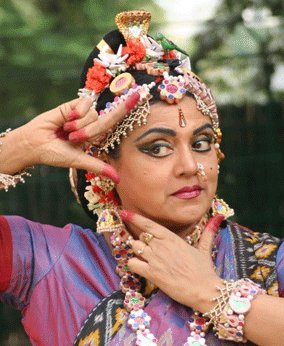
|
 |

|
 |
Differences between the theatrical, court and ritual traditions of Vilasini Natyam - Swapnasundari, Delhi e-mail: vilasininatyam@yahoo.co.in December 3, 2008  Vilasini Natyam - Repertoire The cultural history of the Telugu people indicates the existence of two formal dance streams - One performed by men (Purusha Sampradaayam) and the other by women (Sthree Sampradaayam). References to a Sthree Sampradayam abound in the archival, epigraphic and literary sources, establishing the vital artistic presence of female singer -dancers in temples, royal courts and public theatres, certainly from the 10th century AD. They were referred to by various terms including Vilasini, Swamini and Bhogini, (colloquially Saani and Bogam) and their troupes termed Chinna Melam or Nattuva Melam. By mid 20th century, these artists were called the Kalavantulu - a term which derives from Kalavati (a woman who excels in the arts). When the Anti-Devadasi Dedication Act was passed, the consecration of singer-dancers in temples was banned. It was then that the art of the Kalavantulu began to decline. Saanis and Bhogams were distanced from mainstream social life only thereafter. Vilasini Natyam represents the ritual, ceremonial and dance operatic legacy of this group, a section of whose last living artists have taught dancer Swapnasundari. This art differs in technique from the Purusha sampradayam presently represented by Kuchipudi. Though Vilasini Natyam movements appear quintessentially feminine, its hundred-odd Adavus (dance-units) include the Tandava (vigorous) and Lasya (soft) aspects. Vilasini Natyam's complex Abhinaya is widely admired. Its extensive repertoire comprises Temple dances, Court dances and Dance operas of the hereditary female singer-dancers of Telugu origin. These are vital-requirements of formal Indian dance systems, some of which came to be described as “classical” dance-styles after the advent of the English language and the subsequent application of English terms to describe indigenous traditions. Temple repertoire (Aalaya Sampradaayam / Gudi Seva) Vilasini Natyam's temple repertoire contains the following: a) Song-dance which is offered as an integral part of the Agamic worship inside a live temple, primarily for the pleasure and appeasement of the deity. Vilasini Natyam is re-integrated with live worship in the 400 year-old Sri Ranganatha Swamy temple, Rang-bagh, Hyderabad. The Agamic ritual-dances, once the prerogative of consecrated temple dancers are presently performed inside a living temple by female and male Vilasini Natyam dancers. The near-obscure original Choornikas (Sanskrit stanzas) and Talams (rhythmic metres ) pertaining to these have been reclaimed and restored to dance-worship after a lapse of nearly 80 years during which only nominal Mantra chanting by the priests had continued. This landmark achievement of Vilasini Natyam has been sustained for over 12 years. Modified versions of these rituals for Vilasini Natyam stage-performance retain the important components. Elaborate Tala expansion now embellishes the earlier Nrittha items, which were of simpler construction. Aasthaana Sampradaayam / Kaccheyri Aata This repertoire of Vilasini Natyam evolved from the following: a) Concerts in a temple: As the dancer of yore performed facing the sanctum, the audience of worshippers could watch from close quarters. Prarthana, Varnam, Padam, Javali, Adhyatma Ramayana Keertanam, Ashtapdi, and Shlokam, were some of the items performed. The concert lasted many hours. Temple singer-dancers were also required to welcome royalty during their temple visits. On such occasions, the virtues and achievements of the royal visitor would be extolled through compositions like Salaam-Daruvus. b) Concerts in royal assembly: Temple dancers were invited to perform in the court on special occasions. Over time, some of them gained full-time employment as Raja-nartakis (court dancers). A few could retain the temple connection if permitted by the temple & the court. . Many unique Varnams of the Telugu temple and court dancers are presently unavailable in published form. Abhinaya Swayambodhini (Telugu, c1915) gives the text of some Varnams but without their musical notation. Fortunately, most Varnams have survived as oral tradition amongst the descendants of the Saanis and Bhogams. All of these have been recovered and feature in today's Vilasini Natyam performances. More Nrittha has been added. Padam is central to Kaccheyri Aata. The Abhinaya of the Telugu Saanis is extremely detailed. Each word and sentence of the lyric is etched, then the whole Padam extensively elaborated, taking up an hour ! Sanskrit Shlokas are treated similarly. The seated Abhinaya of the Northern school is retained. Manodharma (spontaneous improvisation) remains a vital feature. Aata Bhaagavatham (dance-operas) These were performed by the Gudi-Saanis in the temple courtyard to entertain the pilgrims during special festivals, after the main worship - rituals concluded. The popular dance operas Parijaatham and Golla- Veysha Katha also came to be called Bhaama -Kalaapam and Golla Kaalapam. Vilasini Natyam presentations of Aata- Bhaagavatam retain the Margi (formal) and Desi (regional) elements which characterize its music. Use of the typical Ganiyam (light-weight gilded wooden ornaments) has been revived. Vilasini Natyam endeavours to present, in an educative and aesthetically appealing manner, the total content of the ancient Sthree Nrithya Sampradaayam (female solo dance-tradition) which once dominated Telugu-speaking areas of Southern India. |